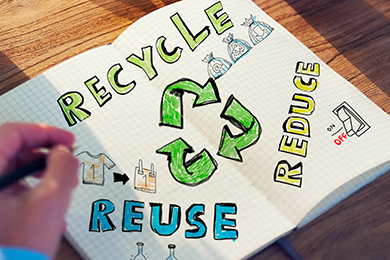
The weaknesses in our economy have become clearer than ever during the pandemic: while Europeans are more aware of the environmental problems caused by packaging waste, especially plastic packaging, a lot of plastic in particular is still being used in Europe as part of efforts to prevent the spread of the coronavirus and its mutations. That’s according to the European Environment Agency (EEA), which says that Europe’s production and consumption systems are still not sustainable – and the plastics industry in particular has to find ways to ensure that plastics from renewable raw materials are used much more wisely, better reused and more effectively recycled. The cradle-to-cradle principle defines how we can move away from waste management.
In Europe and other industrial nations, business is generally a linear process: from the cradle to the grave. We take resources from nature and produce goods from them that are used and consumed. We then throw away what we consider worn-out and irreparable commodities, thereby creating mountains of waste. One factor in this is our lack of appreciation for natural resources, of which we consume too much, indeed more than we have. Europe’s economy has had to import natural resources for years and is thus becoming dependent on them, which may put the continent at a disadvantage when competing for precisely these resources in the foreseeable future.
Then there is our careless treatment of waste, which we have not been able to cope with within Europe’s borders for a long time now. According to the European Parliament, energy recovery (the recovery of thermal energy through incineration) is the most used way to dispose of plastic waste, followed by landfill. 30% of all plastic waste is collected for recycling, although actual recycling rates vary from country to country. Half of the plastic collected for recycling is exported to be treated in countries outside the EU. In summary, waste does not go round and round.
Circular instead of a linear economy: cradle to cradle, not cradle to grave
But there is a way to get our economy going round and round: the cradle-to-cradle material cycle principle cuts out the waste. All materials in a C2C economy cycle through closed (biological and technical) loops. German process engineer and chemist Michael Braungart came up with the C2C concept. He believes that this gives us a blueprint that leads away from today’s approach to environmental protection, involving the use of downstream environmental technology, and towards product innovation. The European Union (EU) is pursuing precisely this goal with its Circular Economy Action Plan, which is a central part of the European Green Deal and, among other things, sets out objectives for the top of the sustainability chain – product design.
In the future, in keeping with the environmentally friendly principles of the C2C concept, we would use consumer goods but not consume them. They would remain the property of the manufacturer, who would be responsible for their disposal – taking the burden off of consumers. At the same time, manufacturers would be under a constant obligation to optimise their goods in accordance with the changing conditions within their closed technical cycle. According to Michael Braungart, it would have to be possible to recycle goods again and again without reducing their material or intellectual value.
Michael Braungart has called for consumer goods to be produced in a manner that is as natural as possible so that they can be composted at any time.
With C2C, there would no longer be any such thing as a non-recyclable good.
To avoid packaging waste, we need to rethink packaging
The EU Action Plan focuses on a number of areas, including avoiding packaging waste. According to the European Commission, the amount of materials used for packaging is continuously growing. In 2017, the figure was 173 kg per EU inhabitant. As per the Action Plan, it will have to be possible to reuse or recycle all packaging placed on the EU market in an economically viable way by 2030.
The following problems will have to be solved for this to happen: current packaging is difficult to reuse and recycle. It takes a great deal of effort to break down so-called composite materials in particular, such as beverage cartons, into their cellulose, aluminum foil and plastic foil elements after just a single use: the paper first has to be separated from the foil and this process consumes a lot of water. Only low-quality packaging, such as egg cartons, can then be produced from the paper. The aluminium and plastic can be used in the cement industry for energy production and quality improvement.
Environmentally friendly packaging for the C2C economy
According to C2C NGO, this type of recycling does not constitute cradle-to-cradle use, however, and it is time to rethink packaging entirely.
Environmentally friendly packaging would have to take account of the nature of the materials. The individual components would have to be easy to separate so that they could be circulated in cycles after use. This means that they would have to be modular and easily separable for the recycling process or be made from a single material. Or they would have to be designed for the biological cycle by being made from biodegradable paper and ink. Essentially, the materials – plastics, pulp, ink and additives – would have to be precisely defined, robust and high-quality and could not contain any toxins that could transfer to food, people or the ecosystem.
We have a blueprint for a cradle-to-cradle economy. We now just need to follow it, step by step.
Copy from Internet resources
Post time: Mar-18-2021




